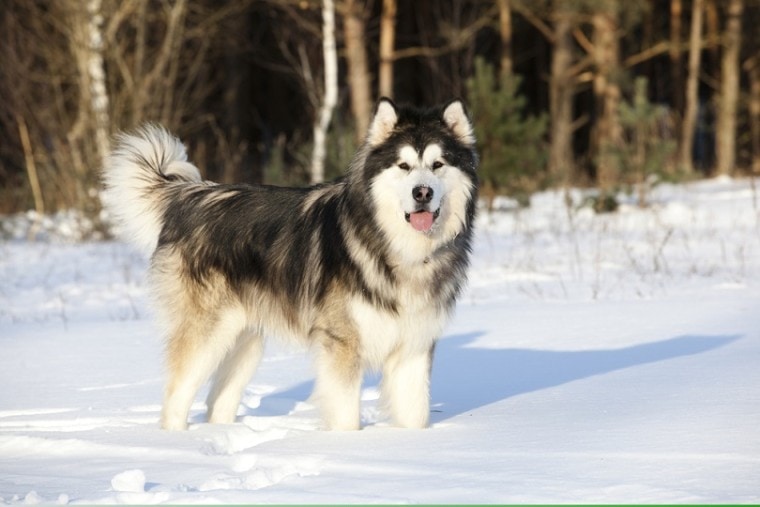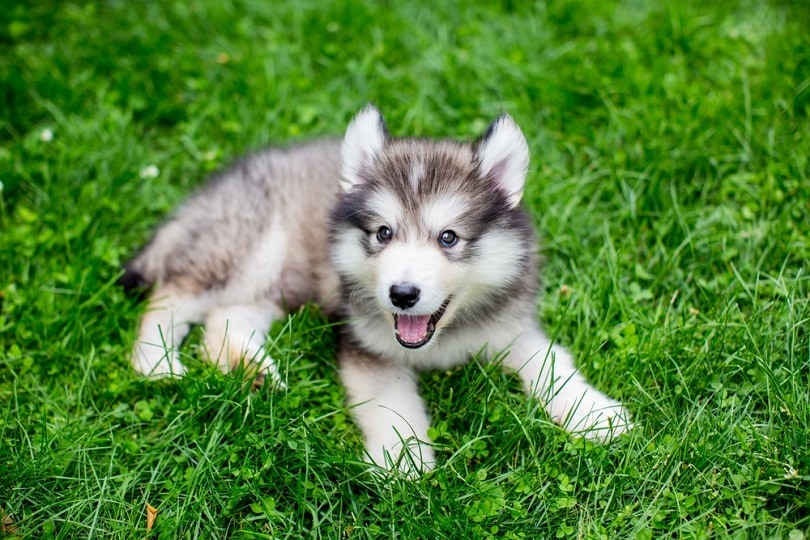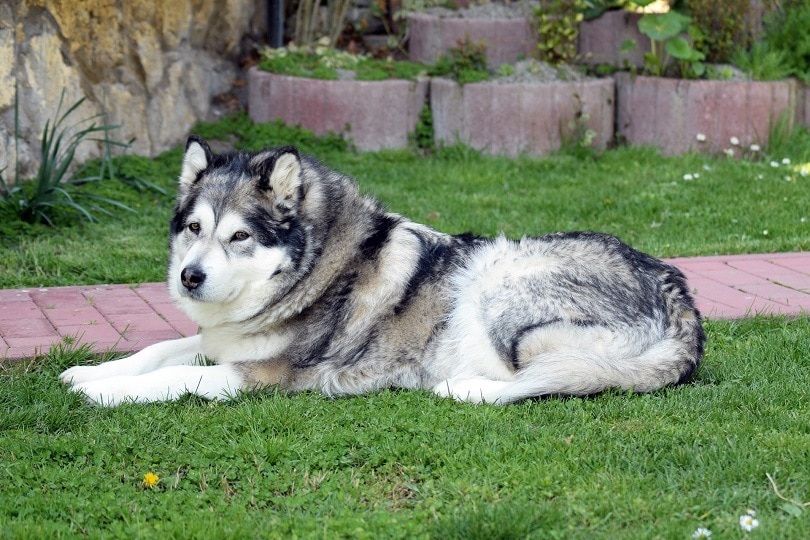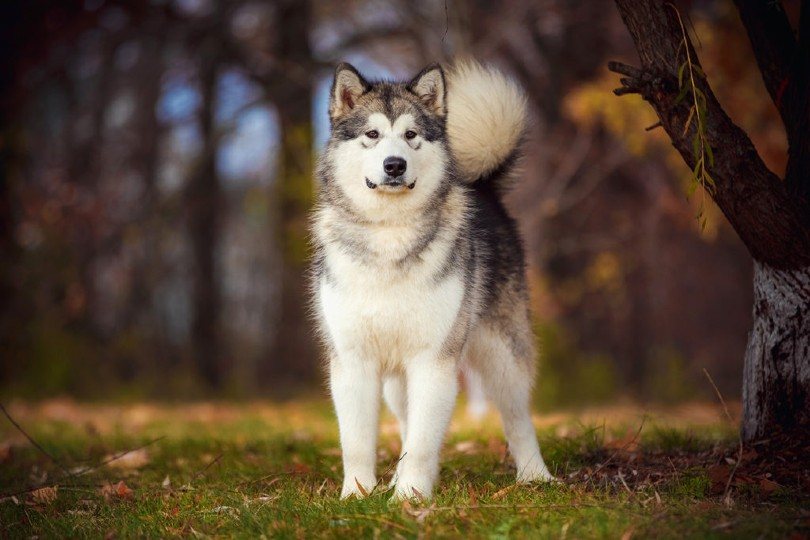
Click Below to Skip Ahead
Highly active families often have a hard time finding a dog that can match their energy unless they were explicitly bred for hard work. Alaskan Malamutes are the definition of a working dog. This breed was initially bred for dog sledding. They have heavy bones, strong shoulders, and a dense coat that made them perfect for harsh life in the north.
Breed Overview
Height:
23 – 25 inches
Weight:
75 – 85 pounds
Lifespan:
10 – 14 years
Colors:
Grey, black, white, sable, red
Suitable for:
Active families looking for a dog to take on adventures
Temperament:
Affectionate, loyal, playful, intelligent
As time progressed, people started appreciating these dogs’ playful and loving nature alongside their ability to work hard. Their extra fluffy coat makes them undoubtedly adorable, and their trainability keeps them as a top contender as a family dog. When they aren’t howling for fun, their personalities shine through in other ways.
However, just because they are cute and quirky doesn’t mean that this breed is suitable for everyone. If you aren’t able to supply them with some basic needs, you’re going to regret buying one based on looks alone.
Alaskan Malamute Characteristics
Alaskan Malamute Puppies

There is a lot to consider about this specific dog breed. Although they are brilliant and relatively easy to train, they have some of the highest energy levels of all other dog breeds. They require a lot of land or yard to run and play, and they aren’t great for families who live a more sedentary lifestyle.
Alaskan Malamutes stick around longer than some other dog breeds, but that doesn’t come without a few general health issues that you may want to pay attention to. You might have to consider if you’re able to afford to care for these issues when they arise in the future.
Although Alaskan Malamutes are friendly to people, that doesn’t mean they are friendly to other dogs. The earlier to socialize these dogs, the better. Malamutes who were taken away from their mom and littermates too soon often show signs of aggression towards other dogs than those who stayed with their mom and siblings for at least six weeks.
Temperament & Intelligence of the Alaskan Malamute
Are These Dogs Good for Families? 👪
Even though they are known as powerful animals, these dogs aren’t one to be afraid of if you’ve got children running around. Malamutes are amazingly patient and gentle with children. They love getting constant attention from family members, and their unique personalities make them instantly feel like a welcome addition.
With this in mind, they are large dogs, and teaching your children how to behave around them is equally important. Young children should be supervised around the dogs until they learn that pulling on their ear, tail, and fur isn’t a nice way to treat them. If you have other pets, socializing them from a young age is the best way to guarantee that they won’t have any fights or spats with the other animals in the house.
Alaskan Malamutes demand a lot of time for grooming, and this is often made easier when you have a lot of small hands on deck. Assigning chores like brushing and bathing the dogs helps your new pet live a healthier life while teaching your kids the importance of taking care of a living creature.
Things to Know When Owning an Alaskan Malamute
Owning Alaskan Malamute comes with a lot of work that most people aren’t prepared for. They have special requirements regarding diet, grooming, and exercise, and all play a role in their overall health and lifespan. If you’re not able to meet all of these requirements, you might consider a breed with less upkeep.
Food & Diet Requirements 🦴
The amount of food your dog gets should factor in their weight, age, and overall health. Just because they are large, active dogs doesn’t mean you can feed them whatever you want throughout the day.
Alaskan Malamutes do best on either a high-quality kibble or raw diet. Most Malamutes need about 2 cups of food per day, depending on their activity level. If you’re unsure about the amount of kibble your dog should receive, contact your veterinarian so they can help you make the best-informed decision.

Exercise 🐕
We weren’t lying when we said this dog breed has an extremely high energy level. If you’re at work all day or live in a small apartment, you might notice that your Malamute is acting out and creating damage around your home.
Alaskan Malamutes have to expend a lot of pent-up physical and mental energy. Give these dogs at least 1.5 to 2 hours of vigorous exercise every day to keep them healthy and prevent future illnesses.
Grooming ✂️
Alaskan Malamutes showcase a dense coat with double layers. The outer coat is thick and coarse for added protection. The inner coat is wooly and oily to protect them from freezing-cold temperatures and wetness.
Because of the amount of hair they have, expect to brush these dogs 1 to 3 times per week in order to keep shedding to a minimum. Malamutes have two heavy sheds twice per year where their hair falls out in large clumps as the weather changes.
On top of brushing, there are a lot of other demands that must be met. Brush their teeth once a month and keep their toenails trimmed to a practical length. Check their ears for foul odors or red colors to make sure they don’t get ear infections, and perform a thorough body exam every few months to steer clear of any sores, rashes, or infections.

- You might want to check this out: 11 Best Dog Wipes: Reviews & Top Picks
Health and Conditions 🏥
As with all pets, there are some conditions that are more likely to appear in this breed than others. Malamutes are generally very healthy, but it’s always best to keep your eye out for severe conditions.
 3 Little-Known Facts About the Alaskan Malamute
3 Little-Known Facts About the Alaskan Malamute
1. They are one of the oldest dog breeds in the world.
We know that Alaskan Malamutes were, and still are, used as sled dogs, but this breed’s history goes back much further than you think. Alaskan Malamutes are believed to be some of the first domesticated wolf dogs that accompanied Paleolithic hunters across the land bridge that leads from Siberia to Alaska. These humans settled in the Seward Peninsula with the Mahlemut tribe. They were used for hunting seals, chasing away predators, and pull heavy sleds loaded with food and other supplies.
2. They don’t bark much but love to howl.
One of the top questions among people who are considering buying an Alaskan Malamute is usually about if they are loud. Because they are so closely related to wolves, Malamutes don’t bark nearly as much as they prefer to howl or sing. A random siren or heartfelt song can set them off and make them talk and woo for as long as they feel like.
3. They are notorious diggers.
Sure, they may be trainable, but one thing that you’re never going to stop is their digging. Alaskan Malamutes love to dig, and it is one thing that owners won’t be able to train out of them. Instead of fighting them on this, give them a designated area to dig so they can get all their wound-up energy out before coming back inside and destroying other things.
Final Thoughts
With all of this in mind, Alaskan Malamutes want an alpha to follow and a pack to love. They are a faithful companion who expects to be by your side with every adventure you take. Though they do love a warm cuddle session here and there, they are suited for the outdoors and are going to do best with an owner or family who enjoys being active and having their furry companion with them while they do it.
They may be so fluffy that it is hard to resist, but bringing home a new dog is a serious responsibility, and it is up to you to ensure that the breed fits into your home and lifestyle so that neither you nor the dog is living in a way that is detrimental them.
Alaskan Malamutes are funny, smart, personable dogs, and if you do decide to make one a member of your family, it’s a decision that you won’t regret.
Featured Image Credit: Liliya Kulianionak, Shutterstock








